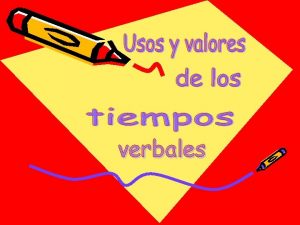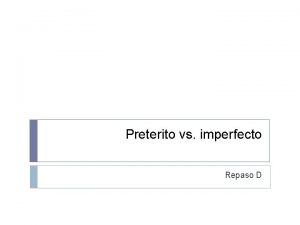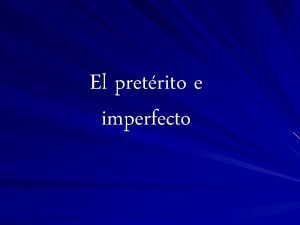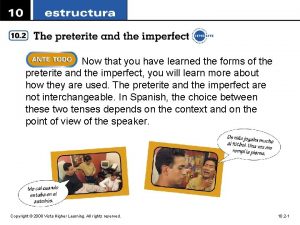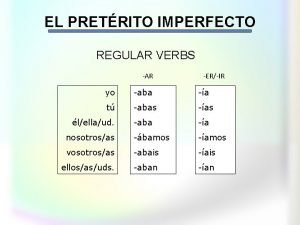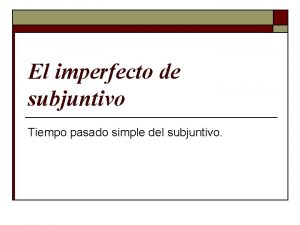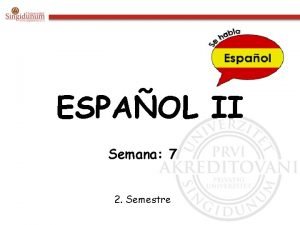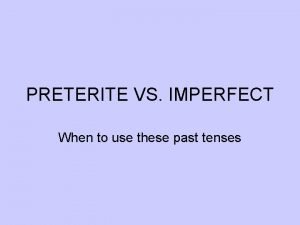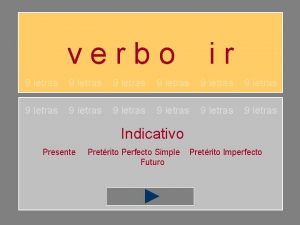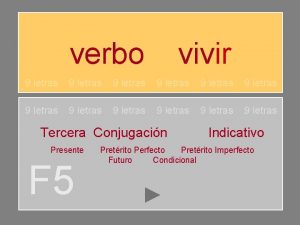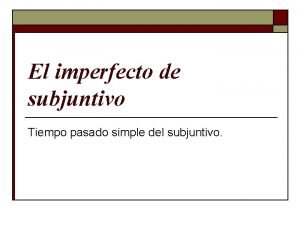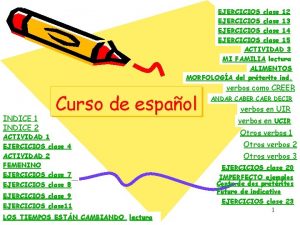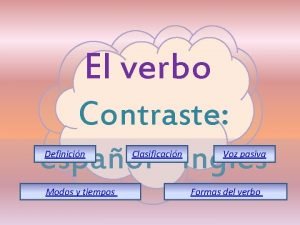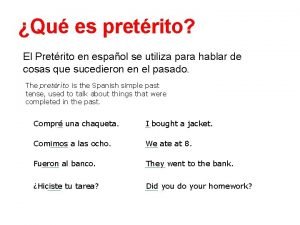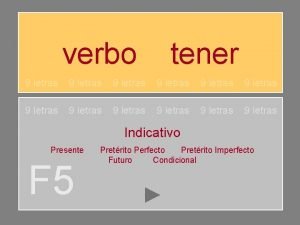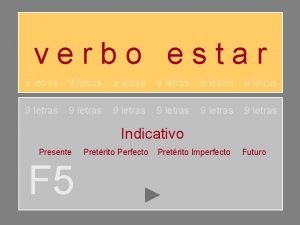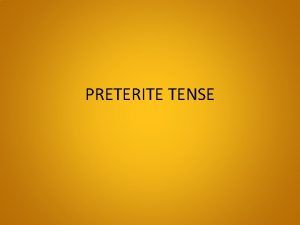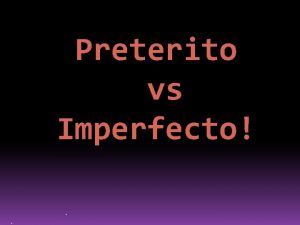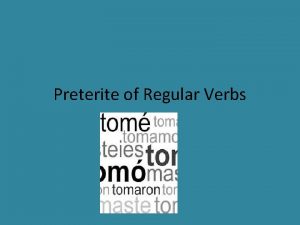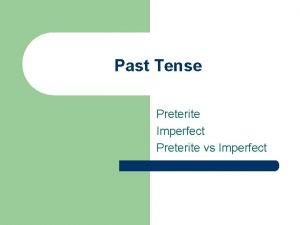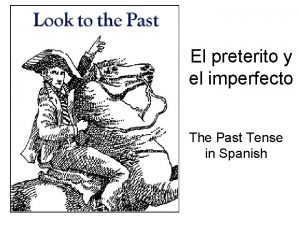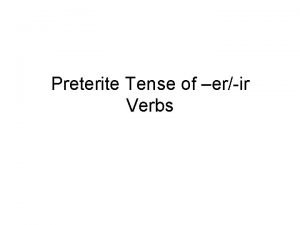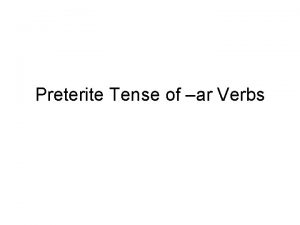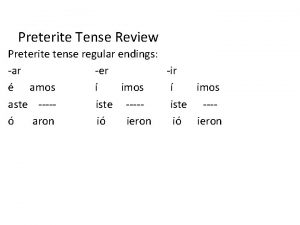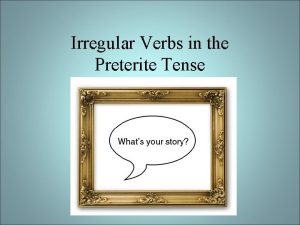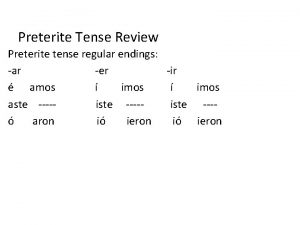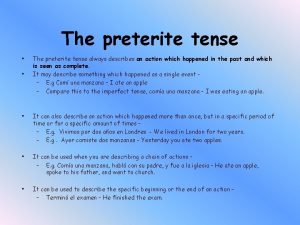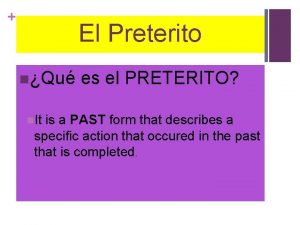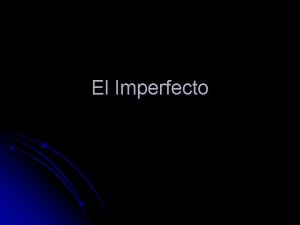PRETERITO E IMPERFECTO The preterite tense The preterite



















- Slides: 19

PRETERITO E IMPERFECTO

The preterite tense The preterite allows you to refer to specific past actions performed. (1) at a fixed point in time, (2)a Specific number of times, or (3) during an enclosed amount of time. If the action is in the past and you can pin-point it as to when or how many times it occurred, you will use the preterite tense.

Fixed Point in time I called you at 3: 00 Te llamé a las 3: 00 He bought the car on Tuesday after noon. Se lo compró el martes en la tarde We saw the movie last night. Vimos la pelicula anoche.

Specific number of actions I called you five times Te llamé cinco veces. They ate ten sanwiches. Comieron diez sandwiches. She read the book twice. Leyó el libro dos veces

Enclosed amount of times I worked for 8 hrs. Trabajé por 8 horas The movie lasted two hrs. La pelicula duró dos horas. He lived there for two years Vivió allí por dos años

The imperfect tense We use the imperfect tense when referring to actions that took place in the past either repeatedly or over an extended period of time. Unlike the preterite, which is used to specify and action either at a particular point in time or number of times. The imperfect indicates that an action took place during a non-specific time or was repeated an indefinite amount of times.

The imperfect tense The element of time, though certainly in the past, is necessarily not specific. It is impossible to determine when the action began or ended, or the exact time or number of times it occurred. 1. I used to live in St. Luis 2. John always ate cereal for breakfast 3. Mary was a good conversationalist.

Empecemos con el infinitivo. Quitemos la terminación. hablar comer vivir habl com viv Añadamos la terminación nueva para el imperfecto. . . hablaba hablábamos comíamos vivía hablabas --- comías vivías hablaban comían --- vivíamos --vivían

¡Hay solamente verbos irregulares! ser ir era éramos eras --- iba era ibas --- veía iba veías --- eran íbamos iban ver veíamos veían

El Imperfecto Todos los días Siempre Frecuentemente Mientras De niño Regularmente A menudo A veces Cada día Todas las mañanas Every day Always Frequently While As a child Regularly Often Sometimes Eachday Every morning

Rule #1 habitual actions in past Habitual or continuous action in the past : in English we often use the phrase “used to” as in “ I used to live in Texas” or “they used to eat at that restaurant”. In these cases there is no indication of when or how many times this action occurred or for how long.

Rule # 2 Basic, simple description Very often an important element in sentences in the imperfect is simply a description of how things were. Whereas the preterite emphasis physical action. The reference is to what things were like, rather than what happened. I bought the car. Preterite (specific action) The car was red. Imperfect (description) Ana got married. Preterite (specific action) Ana was married. Imperfect (description)

Rule # 3 “ing” progressive in the past We have learned present progresive = Estar (conjugated) + ado (ar) ido (er, ir) References to such action in the past “I was working” generally omit mention of a specific length of time therefore they are in the imperfect. EX: I was playing and John was singing Yo tocaba la guitarra y Juan cantaba.

#4 Mental or emotional action or physical sensation. Feelings and mental actions usually are not bound by time or number of occurrences. These actions are not physical; rather they describe a state of being, and thus are continuous. In fact, several of the verbs listed below change greatly in the preterite. No creíamos el cuento Estabas cansado Romeo amaba a julieta

Verbs with emotion or feeling often used in the imperfect Amar = to love Conocer = to know Doler = to be painful Creer = believe Esperar = to wait/hope Estar = to be Gustar = to like llevarse bien = to get along Molestar = to be bothersome Odiar = to hate Pensar = to think Poder = to be able to Querer = to want Saber= to know Sentir = to feel

Words or phrases that imply frequency If an action is habitual or frequent you conjuate it in the imperfect

El Imperfecto Todos los días Siempre Frecuentemente Mientras De niño Regularmente A menudo A veces Cada día Todas las mañanas Tantas veces Every day Always Frequently While As a child Regularly Often Sometimes Eachday Every morning So many times

Clock time and age in the past When referring to the time of day or one’s age in the past always use the imperfect. There are only two verbs involved here. Ser (ser clock time)and tener for age. Note that references to time and age often are made with regard to other actions, and that these actions often (but not always) are in the preterite.

Clock time and age examples Era la una cuando llegué. It was one when I arrived. Yo tenía diez años cuando conocí a. Juan. I was ten whem I met Juan.
 Preterito perfecto simple terminacion
Preterito perfecto simple terminacion Dos acciones pasadas en la misma frase
Dos acciones pasadas en la misma frase Pretrito imperfecto
Pretrito imperfecto Intentalo elige el pretérito o el imperfecto
Intentalo elige el pretérito o el imperfecto Realidades 3 capitulo 2 preterito vs imperfecto
Realidades 3 capitulo 2 preterito vs imperfecto Imperfecto vs preterito
Imperfecto vs preterito Pretérito indefinido ir
Pretérito indefinido ir Felipe nos dijo que no hacía buen tiempo para que tomates.
Felipe nos dijo que no hacía buen tiempo para que tomates. Verbo imperfecto ejemplos
Verbo imperfecto ejemplos Marcadores temporales perfecto
Marcadores temporales perfecto Imperfect or preterite for weather
Imperfect or preterite for weather Voy vas va vamos vais van
Voy vas va vamos vais van Vivir futuro
Vivir futuro Concordancia de tiempos
Concordancia de tiempos Verbos que diptongan ejercicios
Verbos que diptongan ejercicios Pretérito imperfecto ingles
Pretérito imperfecto ingles El imperfecto del subjuntivo
El imperfecto del subjuntivo Copretérito indicativo
Copretérito indicativo Verbos con 9 letras
Verbos con 9 letras Estar imperfecto
Estar imperfecto
